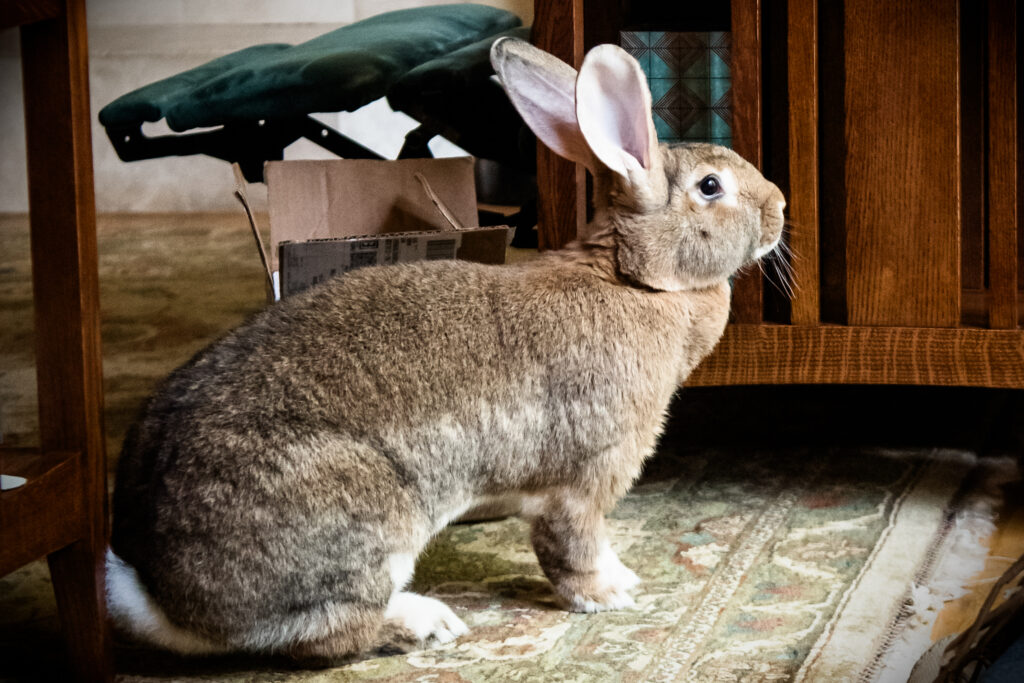A brief review will be given describing the anatomy and function of the rabbit liver. A discussion of diagnosis of liver disease, specific diseases that can affect the liver, and potential treatments for these diseases to help the rabbit caretaker better understand why their rabbit may have elevated liver enzymes and what this can mean and why their veterinarian recommends certain tests for rabbits with suspected liver disease and how this can help guide treatment and determine the prognosis for recovery.
Anatomy and Function
The rabbit liver is divided in left and right regions by a deep cleft with the right and left lobes further divided into anterior and posterior lobules.[1] There is a quadrate lobe, which is behind the gallbladder. Lastly, there is a small circular lobe called the caudate lobe next to the right kidney. This lobe has a narrow attachment that makes the caudate lobe prone to displacement and torsion.[2] The gallbladder is deep within the abdominal cavity. There are separate openings for the bile duct and pancreatic duct in the duodenum, which is the first part of the intestinal tract after the stomach.[2] Interestingly, unlike most other mammalian species, rabbits secrete mainly biliverdin in their bile, as opposed to bilirubin.[2] Rabbits produce a large amount of bile, approximately 250 mL a day, which is 7 times as much as a dog on a weight basis.[3]
Diagnosing Liver Disease
Rabbits with liver disease may present with a variety of clinical signs ranging from slight depression to serious illness. Based on a physical examination, further testing such as radiographs, bloodwork, ultrasound or other tests may be indicated. Here is a brief summary of some of the key bloodwork changes that may occur with liver disease[1]:
Alanine Aminotransferase (ALT): This enzyme is of limited use for rabbit liver disease since ALT is found in many tissues.[3] However, if ALT is significantly elevated, it may indicate liver inflammation and necrosis (such as that caused by parasites, and or hepatic lipidosis).[3]
Alkaline Phosphatase (ALP): ALP is found in many tissues including bone, intestine, gall bladder, kidney, placenta, and liver. Because the highest levels in the liver are in the cells surrounding the bile ducts, liver conditions causing bile stasis may cause ALP elevations.
Aspartate Aminotransferase (AST): This enzyme is also found in a variety of tissues in the rabbit including the liver, heart, pancreas, and muscle. Liver cell necrosis may cause elevations in this enzyme.
Gamma Glutamyltransferase (GGT): Elevations in GGT are very specific for rabbit liver disease. This makes this an important enzyme to measure when liver disease is suspected and elevations occur with liver cell damage and bile stasis.
Bilirubin and Bile Acids: Elevations in bilirubin in the rabbit can occur with bile obstruction. Unlike many other mammals, rabbits do not usually become jaundiced with liver disease. Bile acids may be elevated with liver disease in the rabbit.
Serum Albumin: The liver is responsible for making albumins; therefore, decreases in serum albumin levels can indicate severe liver disease.
Other Diagnostic Tests
Radiographs are helpful in diagnosing liver disease. Changes in size, shape, density, and position should be noted.[1] Ultrasound is a non-invasive technique that can often be performed without sedation or anesthesia, which is ideal in a rabbit with potential liver disease. When sedation is used, ultrasound can be used to collect fine needle aspirates or biopsies of the liver. These aspirates or biopsies should be submitted for histopathology with special stains to determine the exact cause of the liver disease. If ultrasound-guided aspirates or biopsies are not diagnostic, a laparotomy exploratory surgery) or endoscopic evaluation may also be used to examine the liver directly and collect samples for analysis.
Liver Diseases and Treatments
Supportive care is a large part of treating rabbits with liver disease. Supportive care may include fluid therapy, nutrition support (Oxbow’s Critical Care via force-feeding or placement of feeding tubes), and minimizing stress. Vitamins, such as vitamin B and K, may be helpful if the rabbit has not been eating.[1]
Coccidiosis: Eimeria stiedae is a parasite that can affect the liver of rabbits. This is a common disease in rabbitries and young rabbits. Coccidia may cause depression, diarrhea, weight loss, distension of the belly, and death.[1] Diagnosis can be made by fecal examination but fecal exams can be negative because oocytes are shed intermittently. In severe cases where severe liver damage has occurred the rabbit may die despite therapy. This parasite can be treated with a variety of drugs including sulfa preparations such as sulfadimethoxine or trimethoprim-sulfa combinations. Good hygiene and preventing fecal contamination of food and water bowls help control this disease.
Liver fluke: Fasciola hepatica is a liver fluke that can affect rabbits that graze in pastures containing carrier snails (snails are an intermediate host for the parasite). Diagnosis may be made by a fecal examination. In some cases, the disease may not be detected until necropsy. Treatment is with a dewormer such as praziquantel and removal of the rabbit from contaminated pastures.
Microbial diseases: Bacteria such as Pasteurella multocida, Clostridium piliforme, colibacillosis, salmonellosis, listeriosis, tuberculosis, Taenia cystneros, and parasites such as toxoplasmosis may cause liver disease and death in rabbits.[1] Diagnosis may be made with liver aspirates, biopsies, or cultures. Treatment with various antibiotics may or may not be effective, depending on the severity of the disease and individual response to therapy.
Toxins: Aflatoxins are fungal substances that may be present in mouldy food. Aflatoxins are very toxic to the liver and can cause sickness and death in affected rabbits. Diagnosis may be suspected with liver biopsy and aflatoxin levels in food can be measured. Treatment is mainly supportive and involves the removal of affected food. If severe liver damage has occurred, the rabbit may die before a diagnosis can be made. Lead and other heavy metals may cause sickness and death in rabbits. Diagnosis of heavy metal toxicosis can be made with radiographs and checking blood metal levels.
There are a variety of other toxins, either inhaled or in contact, that can be damaging to the rabbit liver. Most notable is the fact that cedar and pine shavings are cytotoxic (toxic to cells) and may cause liver damage; additionally, these shavings used as bedding could be linked to a higher incidence of tumors.[4]
- Eucalyptus and vermiculite may also be toxic.[6] These materials should be avoided as bedding in rabbits and rodents.
Hepatic Lipidosis: Hepatic lipidosis, also known as fatty liver, describes the abnormal accumulation of fat within the liver cells. This is usually not a primary condition in rabbits but is caused by periods of anorexia. Some of the causes of hepatic lipidosis may be dental disease, diet fibre content that is too low, obese animals that become sick, difficult pregnancies, and others.[1] Radiographs, bloodwork, and ultrasound can help diagnose this condition. Treatment is mainly supportive and includes nutritional support as quickly as possible. Prognosis may be poor depending on the severity of the disease. Interestingly, tea polyphenols (found in green tea) have recently been shown to increase hepatic lipase activity and protect liver cells from fatty degeneration in rabbits.[7]
Neoplasia: Many tumours may affect the liver of rabbits. Lymphoma, bile duct adenoma, and carcinoma are among the most common types of tumours described in the rabbit liver.[1] Tumours in other parts of the body, such as uterine tumours, may spread to the liver. Liver tumours have a poor prognosis, as surgery is usually not an option. Radiographs, ultrasound, and liver biopsy are used to diagnose liver tumours. Blood tests are not good screening tests for liver tumours, as they may be normal until late in the disease. Chemotherapy has been used in rabbits and may help prolong the life of the rabbit if a liver tumour is detected.
Torsion: Liver torsion has been documented in rabbits with increasing frequency. The author has personally been involved with multiple cases of torsion in rabbits. Prompt diagnosis (via bloodwork and ultrasound) and surgical removal of the affected lobe(s) seem to provide the best chance for a positive outcome in an otherwise stable patient.[8]
Conclusion
In conclusion, a variety of diseases and toxins may cause liver disorders in rabbits. Because rabbits show non-specific signs of illness, a complete physical examination is recommended in order to determine what additional diagnostic tests may be needed to further characterize the disease. In cases where liver disease is suspected, bloodwork, radiographs, ultrasound, and liver aspirates or biopsies may be indicated. Prognosis varies depending on the severity of the disease and individual response to therapy. The rabbit owner may decrease the risk of liver disease in their rabbit by avoiding feeding mouldy food and avoiding the use of shavings such as cedar and pine for bedding. In addition, spaying rabbits at a young age eliminates the risk of uterine tumours that can spread to the liver.
References
- Meredith A, Rayment L. Liver Disease in Rabbits. Seminars in Avian and Exotic Pet Medicine 2000; 9(3):146-152.
- Donnelly T. Basic Anatomy, Physiology, and Husbandry. In: E. Hillyer and K. Quesenberry, editors. Ferrets, Rabbits, and Rodents. Philadelphia: WB Saunders; 1997. p 147-159.
- Jenkins J. Rabbit and Ferret Liver and Gastrointestinal Testing. In: A. Fudge, Editor. Laboratory Medicine: Avian and Exotic Pets. Philadelphia: WB Saunders; 2000. p 291-304.
- Pelkonen K, Hannimen O. Cytotoxicity and biotransformation inducing activity of rodent beddings: a global survey using the Hepa-1 assay. Toxicology 1997; 122(1-2):73-80.
- Sabine J. Exposure to an environment containing the aromatic red cedar, Juniperus virginiana: procarcinogenic, enzyme-inducing and insecticidal effects. Toxicology 1975; 5(2):221-235.
- Potgieter F, Torronen R, Wilke P. The in vitro enzyme-inducing and cytotoxic properties of South African laboratory animal contact bedding and nesting materials. Lab Anim 1995; 29(2):163-171.
- Zhang X, et al. Effects of tea polyphennols on hepatic lipase activity in rabbits with fatty liver. Zhonghua Gan Zang Bing Za Zhi (Chinese journal) 2003; 11(2):77-79.
- Stanke N, Graham J, Orcutt C, Reese C, Bretz B, Ewing P, Basseches J. Successful hepatectomy for liver torsion in domestic rabbits: 4 cases. Journal of the American Veterinary Medical Association 1;238(9):1176-83, 2011
©Copyright Dr Jennifer Graham DVM, ABVP, ACZM. All Rights Reserved. Republished with the permission of the author.
Further Reading
Liver Lobe Torsion in Rabbits (researchgate)

